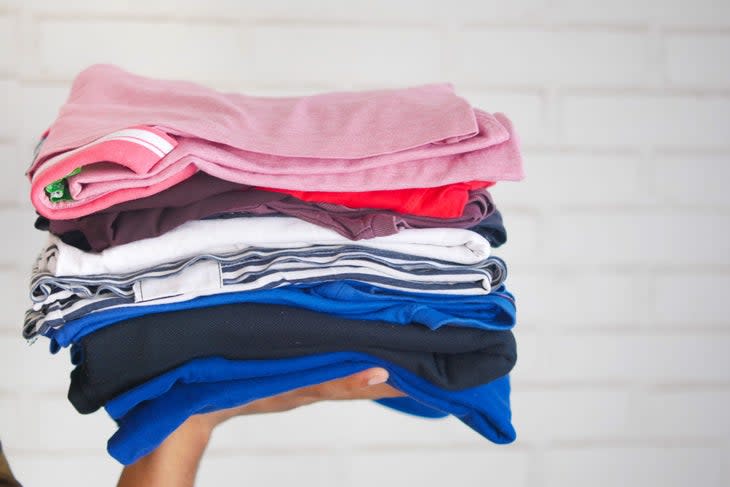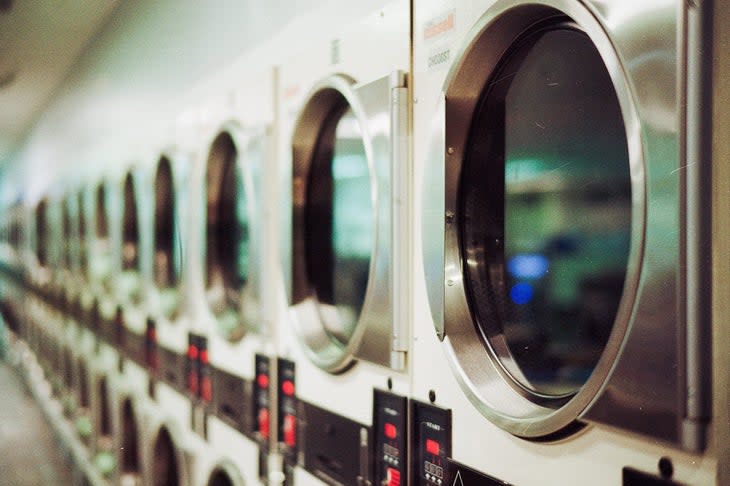Should You Wash Your Running Clothes Less, For the Sake of the Planet?
This article originally appeared on Trail Runner
If you're like me, your laundry basket is filled mostly with activewear: sports bras, athletic shirts, running socks--all things that get only one sweaty use before they are done for the week. The jeans I wear out to drinks with a friend, or the shirt that I wear sitting at a desk all day, go back into the closet, ready for a second, third, or fourth outing. (I'll basically keep wearing an item until I inevitably spill coffee or food on it).
How would you react if someone asked you to wash those funky running socks less often? Or your sports bra, with its propensity for collecting boob sweat? And why on earth might someone ask something so nasty of you?
It turns out that each load of laundry we do is adding to the seemingly endless plastic pollution crisis.
"Everyone has a perception of what they think that crisis looks like, right? They think bags, they think bottles, they think forks, but they don't necessarily think pants, stretchy, comfy materials," says Alexis Jackson, ocean policy and plastics lead at the Nature Conservancy. It was eye-opening to her when she learned about the massive quantity of microplastics that make their way to the ocean from the textile industry.

Washing Running Clothes Releases Microplastics
Lost microfibers are a problem in every step along the lifecycle of a garment--from the initial production to the time it winds up in a landfill. And in between, every time you wash your clothes, microfibers fall away and make their way into the waterways.
Those fibers from the synthetic material in our clothes (nylon, polyester, acrylic) make up a shockingly large percentage of total microplastics found in water. In the San Francisco Bay area, for example, fibers make up nearly half of microplastics found in urban runoff. In other parts of the world, microplastics found in surface water can be composed of up to 90 percent fibers.
It's estimated that around 22 million tons of microfibers will enter the marine environment by the year 2050. And an average load of laundry releases 700,000 fibers per wash, according to a study from Plymouth University.
"What we've learned from textile washing in California, is that when those fibers are shed and released into the water, they go through our treatment facility," says Jackson.
RELATED: The Best Sustainability-Minded Trail Running Gear
The treatment facility is really good at collecting those harmful microfibers and filtering them out. So, problem solved, right?
Not necessarily. To conserve water, that remaining wastewater--called a biosolid--is reintroduced into the environment on fields and crops. "Once [microplastics are] kind of in that agricultural setting, whether it's run off into local streams, or whether it's the potential for those plastics to be taken up into the plants that are being grown, that threat is kind of present for people and nature," says Jackson.
Reducing Plastic Use
We're no strangers to this plastic problem. Everyday we make negotiations within the boundaries of our lives of what we can and can't compromise on. We try to remember our reusable water bottle, we say no to plastic straws, we ask for paper instead of plastic bags at the grocery store.
But we also accept the single-use plastic to-go containers so we don't waste food, and sometimes we buy bottled water when we're thirsty and we didn't remember the reusable bottle. We're not perfect. But as consumers, we're generally trying.
Just like with those macro-plastics, there are steps that can be taken--big and small--to minimize how much of these microplastics make their way into our oceans and rivers.
"If there's a way to prevent them from entering the environment, entering bodies, food sources, water, we should take that," says Jackson.
Here are a few ways we can work together to stop plastics from our clothing from ending up in the environment.
RELATED: The Environmental Cost Of Synthetics

Fix the supply chain.
Like every other issue involving the environment, this is an all-in kind of problem. Yes, there are things consumers can do to help (keep reading for those tips), but it's also going to take the entire clothing industry stepping up.
Those same filters being used in wastewater treatment could also be used by textile manufacturers, for example. Research from the Nature Conservancy found that in the production process, enough fibers are shed that for every 500 T-shirts that are made, one is lost to microfiber pollution.
"While the plastics crisis can seem daunting, the fact that there are already solutions that just kind of need to be leveraged, I think, is really encouraging," says Jackson.
Brands can start to put pressure on their suppliers to work on mitigating fibers released into the environment, either through special filters or actually rethinking how clothing is made. Can fabrics be designed to shed less? Or can brands shift to using more natural fibers over synthetic?
Apparel brands, researchers, retailers, and manufacturers have come together under the Microfibre Consortium to collaborate on how to fix the microfiber problem. Athletic brands like Adidas, Lululemon, Nike, Puma, and Patagonia are among the signatories of the consortium.
"I think that there's increasing awareness of this issue on the brand and the manufacturer side, whether it's on the washing machine side, whether it's on the clothes designer side," says Jackson. "I'm hoping that we will see progress on this, especially as we continue to see these studies that are coming out, showing that there's a problem here."
Wear dirty.
If you're looking for some actions that you can control directly, the most obvious (and probably least popular) intervention consumers can make is to wash their clothing less.
As unappealing as that sounds, activewear brands are also working to make that a possibility. Lululemon, Patagonia, and Rockay, for example, have started to use a silver coating in their clothing as a way to encourage consumers to wash them less. The idea is that silver--when used in key areas of the clothing where sweat tends to gather--can disrupt the development of bacteria, which is what causes our clothes to smell bad. How well the treatment really works is yet to be seen.
When you do eventually wash your clothes (which you absolutely should at some point) washing in cold water and hang drying is the best way to prevent some of that microfiber shedding. Preventing your clothes from shedding will also help them last longer.
RELATED: Running Shoes Are Part Of An Environmental Crisis. Is Change Coming?
Filters, front loaders, and other quick fixes.
Other interventions consumers can take include installing special filters onto your dryer that are designed to collect microfibers. Research shows that external filters can capture from 25 up to 78 percent of microfibers, depending on the brand.
If you're in the market for some new appliances, research also shows that front-loading washing machines emit fewer microfiber than top-loading machines.
Cheaper options like washing bags (like Guppyfriend) or fiber collecting balls (like Cora Ball) are not as effective, but can still reduce microfibers going into wastewater by reducing the amount of fibers shed from clothing in the first place.
If there is one thing to take away from Earth Day this year it is that we are not powerless, nor are we all-powerful. No choice we make is ever perfect, but we can empower ourselves to make better ones.
Jackson reiterates that taking on plastic in this way may seem daunting but is critical. "No single player can solve this on their own," she says. "It's going to take consumers and policymakers and brands kind of coming together to create change."
This story originally appeared on Women’s Running.
For exclusive access to all of our fitness, gear, adventure, and travel stories, plus discounts on trips, events, and gear, sign up for Outside+ today.

